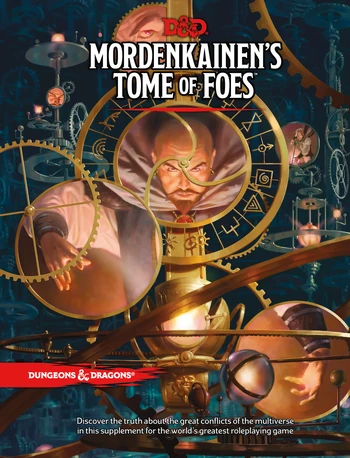 This time around we're covering the third quasi-bestiary sourcebook for Dungeons & Dragons 5th Edition, Mordenkainen's Tome of Foes. This one is sort of a collection of a lot of the monsters published in 5E's other material, particularly the adventure modules, and also accumulates a lot of the named demon lords and archdevils, giving them stats and whatnot. I do plan to eventually cover the adventure modules, but we'll go through this one first because it's a book I actually own.
This time around we're covering the third quasi-bestiary sourcebook for Dungeons & Dragons 5th Edition, Mordenkainen's Tome of Foes. This one is sort of a collection of a lot of the monsters published in 5E's other material, particularly the adventure modules, and also accumulates a lot of the named demon lords and archdevils, giving them stats and whatnot. I do plan to eventually cover the adventure modules, but we'll go through this one first because it's a book I actually own.Where Volo was more of an intrepid explorer, Mordenkainen is one of the oldest and most powerful mages in D&D lore, hailing from the Greyhawk setting, and is also a dude that canonically moves from plane to plane, which is probably why a lot of the monsters here have a bit of a more... extra-planar leaning compared to the 'really weird magical beasts' feel of Volo's Guide to Monsters. In making this review, though, I've done a bit of rearranging the order of how I cover the monsters. Instead of just going in alphabetical order as how the book itself presents the monsters, I've decided to take the massive chunk of demons, devils, demon lords, archdevils and yugoloths cover them separately.
While Volo is more concerned about detailing the culture and tribal focus of a lot of the more monstrous humanoids like goblinoids, orcs, kobolds and yuan-ti, Mordenkainen's focuses more on larger, more specific lore of the Forgotten Realms setting. A significant portion of it focuses on detailing the Blood War between demons and devils, of the 'balance' between the various realms, of the backstory of the elven gods and the history of the dwarves, and it's a pretty fascinating read even if my D&D gaming groups tend to just go for less cosmic-related themes. I've personally never really cared for any of these if I'm being honest, but it's always nice to know and have a little well of established lore to draw on to slap on NPC's or characters.
I did actually read through almost the entirety of the book, but as usual, the focus of this series of reviews is going to be the monster entries. (This focus, I feel, is going to be extra-prominent when we ever get to the actual adventure modules).
Also, I'm basically skipping over some of the races we've covered before -- the drow, the gith, the ogres, the duergar... I really don't feel like I have much to add about them without basically transcripting huge chunks of Mordenkainen's. As usual, since I'm doing the reviews by monster block, I'll include the new enemy variants after a break just for completion's sake. Note that these will be a bit shorter -- this was written when I'm having a bit of a writer's block as I write this batch of Reviewing D&D Monsters, and I feel that these work better as a slightly larger batch of shorter articles..
- Click here for the final part of Volo's Guide to Monsters, covering Nilbog to Yuan-ti.
- Click here for the next part of Mordenkainen's Tome of Foes, covering Eladrin to Nightwalkers.
- Click here for the index.
___________________________________________
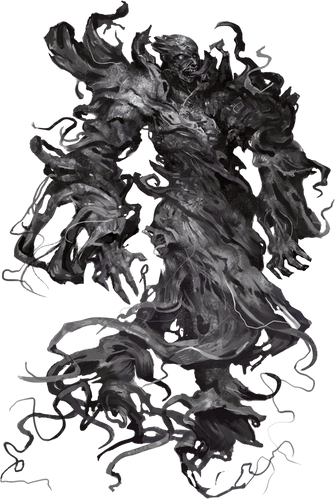

Allip
- 5.5E/5E: Medium Undead; Neutral Evil; CR 5
Allips are very interesting, too -- the origin story is pretty different for 3E and 5E, with 3E's Allips being the undead soul of someone who was driven to suicide because of madness and now spread psychosis like a plague, while 5E's Allips are spectral protectors of mighty secrets... like "hidden truths of the cosmic order", once being seekers of secrets themselves who end up being overwhelmed and transformed into this hideous being due to the contents of the secret, which drives the Allip insane. It's sort of like one of those "knowledge of Cthulhu drives you completely insane" things, except now the poor victim gets turned into something that's stuck protecting the secret. Both 3E and 5E Allips keep trying to drive those around them crazy by spreading their madness, and this translates into deteriorating your adventuring party's sanity -- and 5E even describes how sometimes Allips will go through insidious means of doing this, trying to slowly influence some poor schmuck's dreams and get them to write down the blasphemous secrets that will turn one into an Allip, essentially driving them crazy and manic. Because, of course, only by sharing the monstrous secret lore are they able to pass into the sweet sweet release of the afterlife.
What, pray tell, is a secret that will break someone's mind? "The entire universe is nothing but the collective imagination of a bunch of geeks sitting around a table, joking and rolling dice while they argue about the minutiae of obscure rules. The fate and even the continuation of your reality is determined on how well they roll."

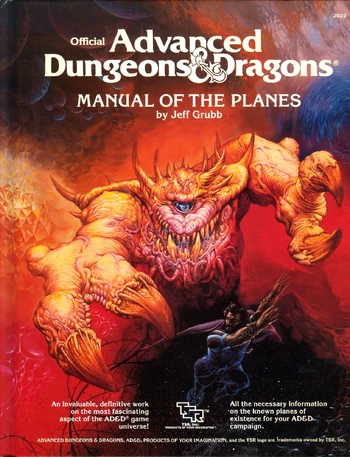
Astral Dreadnought
- 5.5E/5E: Gargantuan Monstrosity - Titan; Unaligned; CR 21
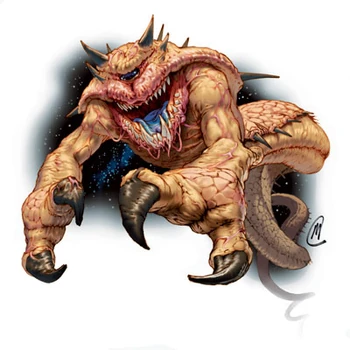 |
| 3E Dreadnought |
The Dreadnought is noted to be "terrifying, but unimaginative", but when you're Space Kraken, you really don't need to be imaginative. All it has to do is to crush, rend and consume everything in its path, and it knows enough to fear spellcasters and turn its eyeball (which contains both an anti-magic field and an insanity-inducing gaze) towards them. I can't remember if 3E and 4E actually gave them backstories, but 5E does, noting that they are created by the Chained God Tharizdun as basically a security measure -- anyone who is able to run around the planes has the potential to enter the Outer Planes, and, in turn, try and meet and/or become gods themselves, so the Astral Dreadnoughts are essentially a living firewall/antivirus program to prevent god-wannabes. That is actually pretty damn cool.



Balhannoth
- 5.5E/5E: Large Aberration; Chaotic Evil; CR 11
I do like the description that the Balhannoth never quite gets all of the details right, which seems pretty much like a great roleplay attempt -- and depending on the vibe of story your GM is trying to tell, this could be a hilarious Saturday morning cartoon villain, or something straight out of a horror movie. In addition to being natural creatures in the Shadowfell, Mordenkainen's Tome of Foes describes how the Drow often make expeditions into the Shadowfell to capture them, tame them and use them as glorified guard dogs. Either way, though, a far, far more interesting creature than how the older editions made it out to be!
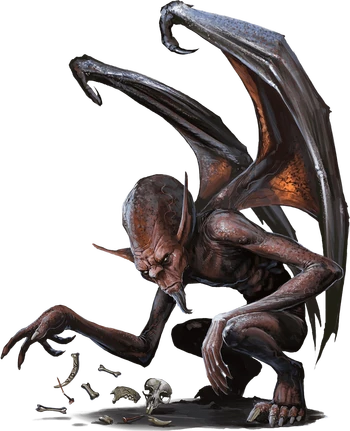
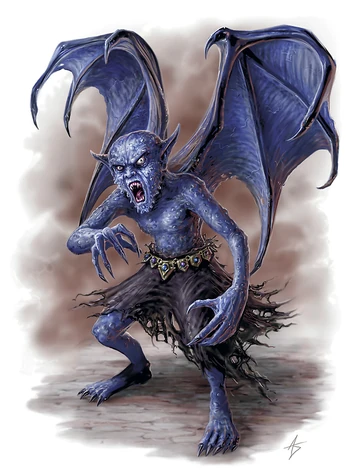
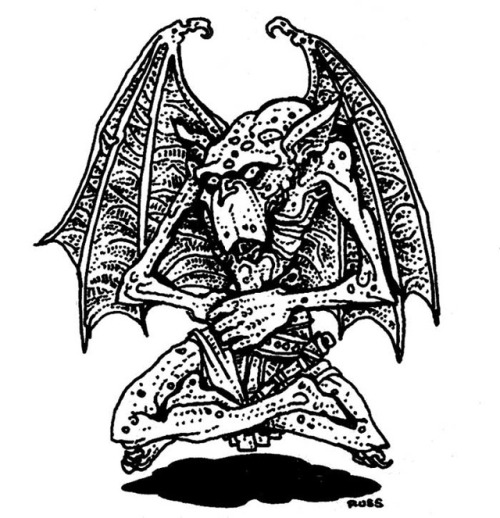
Berbalang
- 5.5E/5E: Medium Aberration; Neutral Evil; CR 2
It's a pretty interesting creature, sort of described more like a strange hermit-like oracle NPC more than something that's actively harmful (notably, in actual combat it's pretty underwhelming) and most of the encounter with a hostile Berbalang is probably going to be a bit of a puzzle to figure out what the fuck it even is. It is still 'neutral evil', but the description in the lore really does make it sound like it's just a highly-introverted asshole instead of a hostile monster in the vein of the allip or balhannoth. Because Mordenkainen's Tome of Foes has a lot of stuff about the Gith, it's noted that the Gith have found a way to co-exist with Berbalangs and utilize them as spies. Not my favourite creature on the book, not by a long shot, but I do appreciate them trying to make it a lot more unique than just a gangly imp.


Boneclaw
- 5.5E/5E: Large Undead; Chaotic Evil; CR 12
Visually, it's a pretty cool variant of the usual undead zombie/ghoul/skeleton look, and both the 3E and 5E artwork does a great job mixing skeletal and muscular structure to make the Boneclaw look pretty badass. The lore given to the Boneclaw being bound to a living murderer is also surprisingly pretty neat, which honestly more than makes up for just how bog-standard a Boneclaw fight would be.


Cadaver Collector
- 5.5E/5E: Large Construct; Lawful Evil; CR 14
And the Cadaver Collector's claim to fame? Well, like those glorious pieces of artwork and its name would tell you, it goes around collecting corpses, and then impaling the corpses on its own massive hunch-back (which itself has a lot of lances and swords stabbed onto it) like some fucked-up version of the real-life assassin bug. Except unlike the Assassin Bug, the Cadaver Collector isn't even doing it for any sort of real benefit. It's just programmed to do that, and that's all it knows. See life? Kill life. See corpse? Stab corpse onto its back. I don't think any sourcebook has given us an origin story for these wacky spiky robots, and I love that they preserve the mystery. Both the 3E and 5E artwork really looks cool, having a very neat combination of horror and whimsy. Like, shit, on one hand, it's a pretty brutal and horrifying creature, a soulless robot who goes around desecrating the dead (and they can even temporarily summon the spirits of their victims to fight for them) but on the other hand... it's essentially a giant freaking Roomba walking through a battlefield, selecting random corpses to collect and display on its back. A lot of fun mystery around this creepy-yet-amusing hell robot, and I do enjoy it a fair bit.
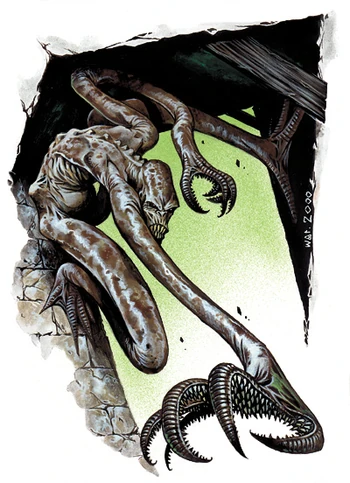
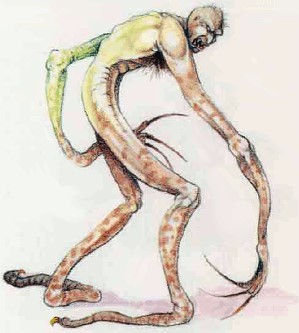
Choker
- 5.5E/5E: Small Aberration; Chaotic Evil; CR 1
Clockwork
- 5.5E/5E: Medium Construct; Unaligned; CR 1 (Bronze Scout), 4 (Iron Cobra), 5 (Oaken Bolter), 4 (Stone Defender)
The Clockwork creatures in Mordenkainen's Tome of Foes are specifically gnome creations, little clattertrap devices that look equally like something that will explode if just one gear is out of place. Gnomes get a bit of a shorter segment in the book and we don't get like any new gnome variants, but this is so much cooler. They sort of fill up the same niche as something like a pseudo-dragon or any other familiar, really -- more of an accessory and something to spice up the gnomes and make a gnome-centric town or something a lot more memorable. Being that they're creations of a very inventive and inquisitive race, there's a lot of random clockwork creatures that any given gnome NPC could throw at you, depending on the GM's preferred sci-fi robot anime or video game of choice. Some people really dislike any sign of technology in their fantasy game, but there's just something about a rattling steampunk clockwork creature that really do fit in more whimsical fantasy, I feel.
The Oaken Bolter is a clatter-trap ballista with a big robo-dragon head. Which... is admittedly not quite as fun as the other three, but I really do love the wacky set of random robot hands that apparently cause the Oaken Bolter to be self-manned, and, obviously, it shoots exploding bolts. And sometimes grapple lines that will reel an enemy in. The Stone Defender is perhaps the most threatening-looking, and hoo boy I love this little one-eyed robot man, who runs around with two big-ass slabs of chunky metal shields that it'll use to protect its buddies, or clobber their faces in. These are the four main Clockworks introduced here, of course, and... it's not that wide of a variety, but the prose really makes it clear that gnomes are very inquisitive, and they'll want a custom-made Clockwork creature, so it's up to the GM to really flex their creativity muscle with these, and Mordenkainen's even adds a list of potential custom abilities that gnome tinkerers could give their personal Clockwork minions!
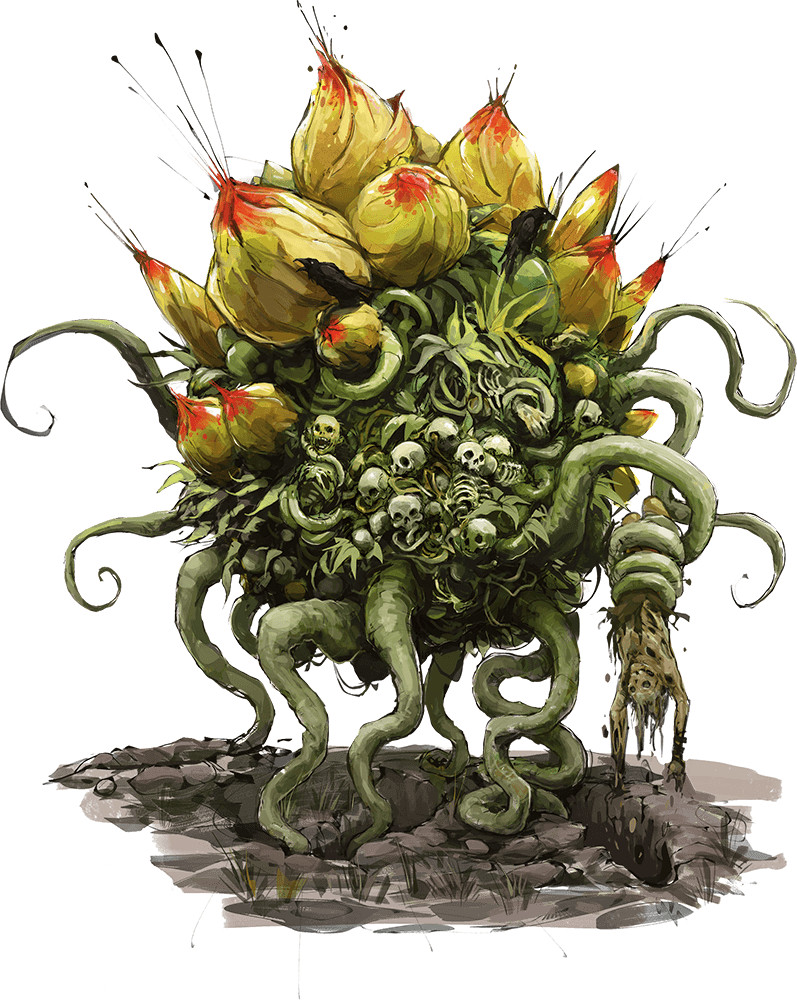
Corpse Flower
- 5.5E/5E: Large Plant; Chaotic Evil; CR 8
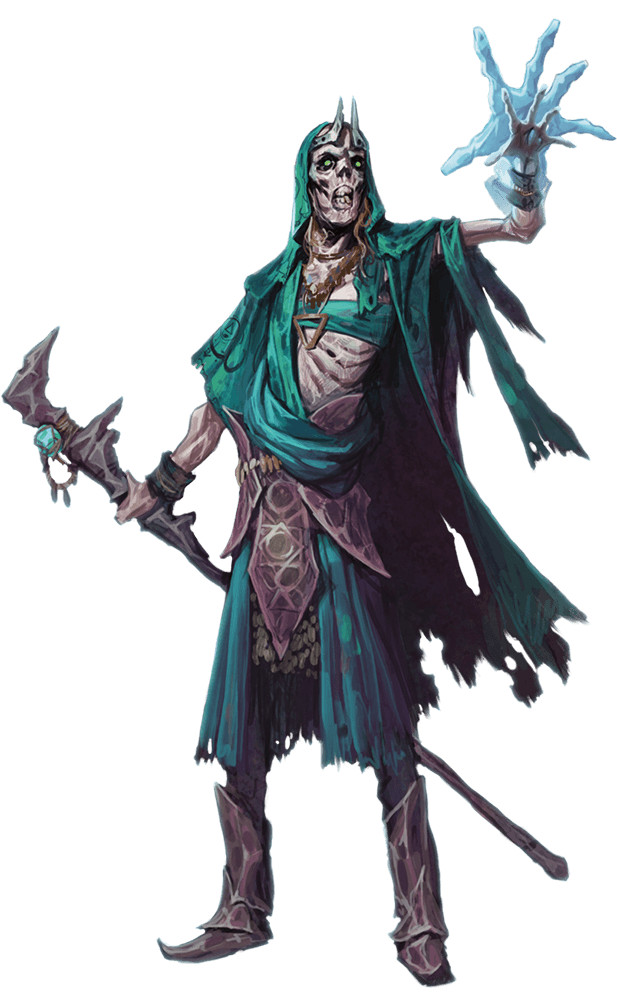
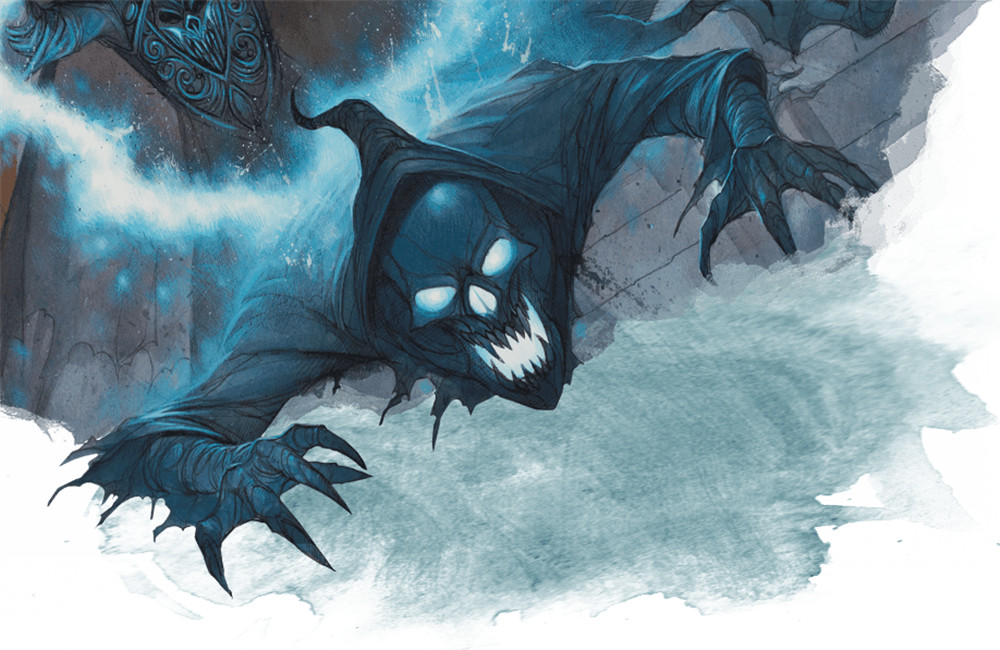

Deathlock
- 5.5E/5E: Medium Undead; Neutral Evil; CR 4 (Deathlock), 8 (Mastermind), 3 (Wight)
Also, it took me way too long (i.e. right before posting this article) before realizing that the "lock" in "Deathlock" refers to Warlock.
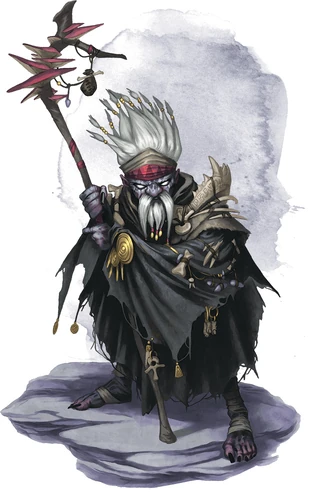
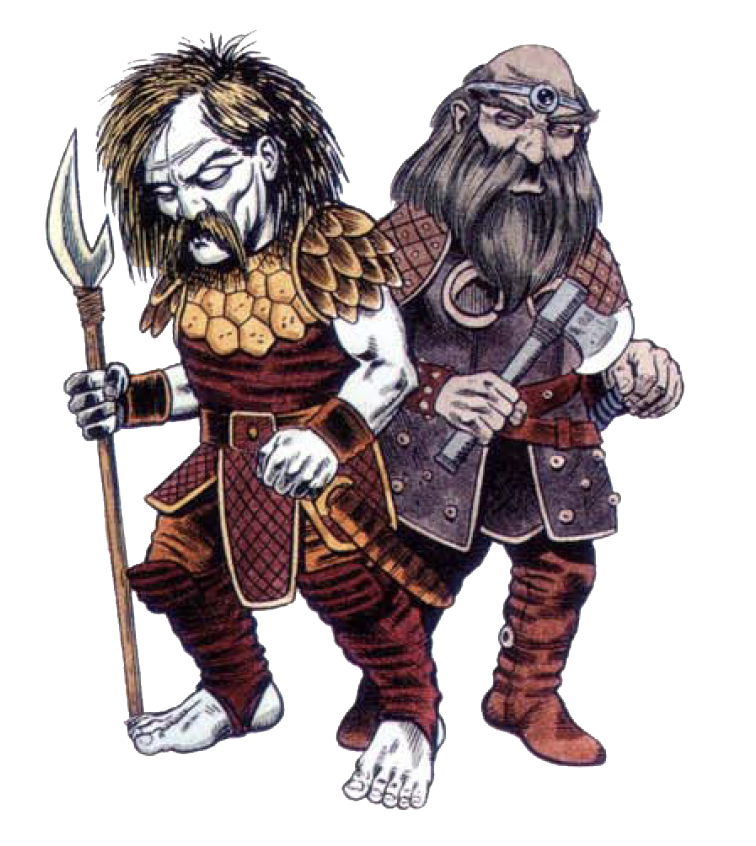
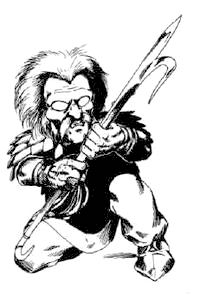
Derro
- 5.5E/5E: Small Humanoid; Chaotic Evil; CR 1/4 (Derro), 3 (Derro Savant)
The Derro's backstory in 5E is that they're apparently a clan that was enslaved by the Mind Flayers and weren't freed alongside the rest of the Duergar. When they eventually did, their mind was so broken and demented that they became, well, this crazy race. The Derro themselves have a different flavour of origin story, involving a pair of insane gods that teach the Derro to be deceitful and cruel. And, of course, to be paranoid and kinda crazy. They make for fun one-off encounters for sure thanks to their quickly madness (and Mordenkainen gives us a table for multiple paranoia subtypes) but ultimately, I've always found Derro to be kind of redundant next to the Duergar.
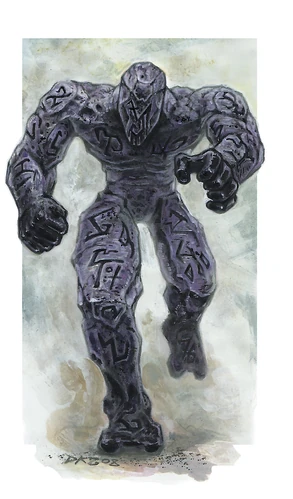
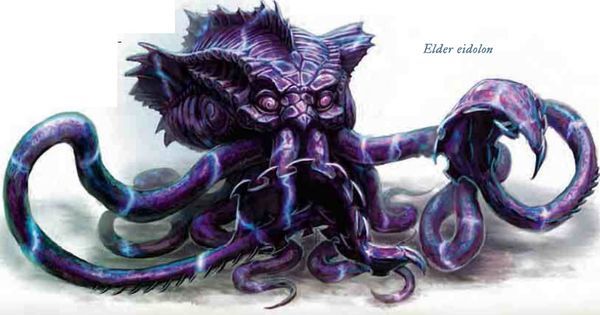

Eidolon
- 5.5E/5E: Medium Undead; Unaligned; CR 12 (Eidolon)
- 5.5E/5E: Large Construct; Unaligned; CR 12 (Sacred Statue)
Anyway, 5th edition's Eidolon is basically a golem with some extra steps. The appearance might look like a generic pot-bellied demon creature, but apparently these Eidolons are actually aligned to the gods, being spirits that are bound by a sacred oath to the gods they worship to safeguard a certain place of importance like a temple or whatever. They hang around the temples unseen, ready to jump an possess and pilot a bunch of specially-prepared Sacred Statues to fight any intruders that would defile their god's temple. So despite looking like generic rock people, these Eidolons are basically faithful zealots and priests who gave up their afterlife to continue serving their gods in undeath. It's a neat trope that I don't think I see enough in D&D modules -- most of these "serve their patron beyond death" monsters tended to be generic screaming evil monsters, and the Eidolon's definitely an interesting twist on the formula. There's a part of the Eidolon that's still very obviously meant to be part of a dungeon crawl, and there's honestly not much beyond that, but it's an all right monster, I suppose.
And... and that's all the monsters we have for today! We'll briefly cover the extra new Drow enemies and whatnot after this.
I wasn't sure if I was going to cover these or not; they're kinda redundant and just slapping a class concept onto an existing evil race, and is just there to be a convenient stat-block if you want to quickly populate, like, a Drow or Duergar warcamp with stronger enemies. I definitely appreciate this from a DM standpoint, but flavour-wise I don't think this one offers a whole ton that's new. At least we get new artwork, though!
Drow
- 5.5E/5E: Medium Humanoid; Chaotic Evil; CR 13 (Arachnomancer), 18 (Favored Consort), 9 (House Captain), 14 (Inquisitor), 20 (Matron Mother), 11 (Shadowblade)
House Captains are picked from a family's noble children and are just stronger warriors. Inquisitors are the Drow secret police, which root out higher-than-normal traitors, which is definitely the norm for these Drow. Matron Mothers are the elderly bosses of each drow noble house, who are masters of manipulation and also have a fair amount of the spider god Lolth's blessing. Shadowblades are assassins that either murder rivals from other houses, or protect the udnerground Drow cities from any monster that might threaten them. Apparently, Shadowblades are created through a ritual where they kill a demon, but prevents it from returning back into the abyss, transforming it into a Shadow-Demon and binding its power to them.
Anyway, very Morrowind, I approve! Morrowind, of course, borrows its fair share of inspiration from D&D drow. None of these are super-duper interesting to me, at least not until you turn these class concepts into actual recurring enemies or NPC's or something, but I do agree that it's necessary to detail them out to basically put a stat block to the different parts of the description of Drow society.
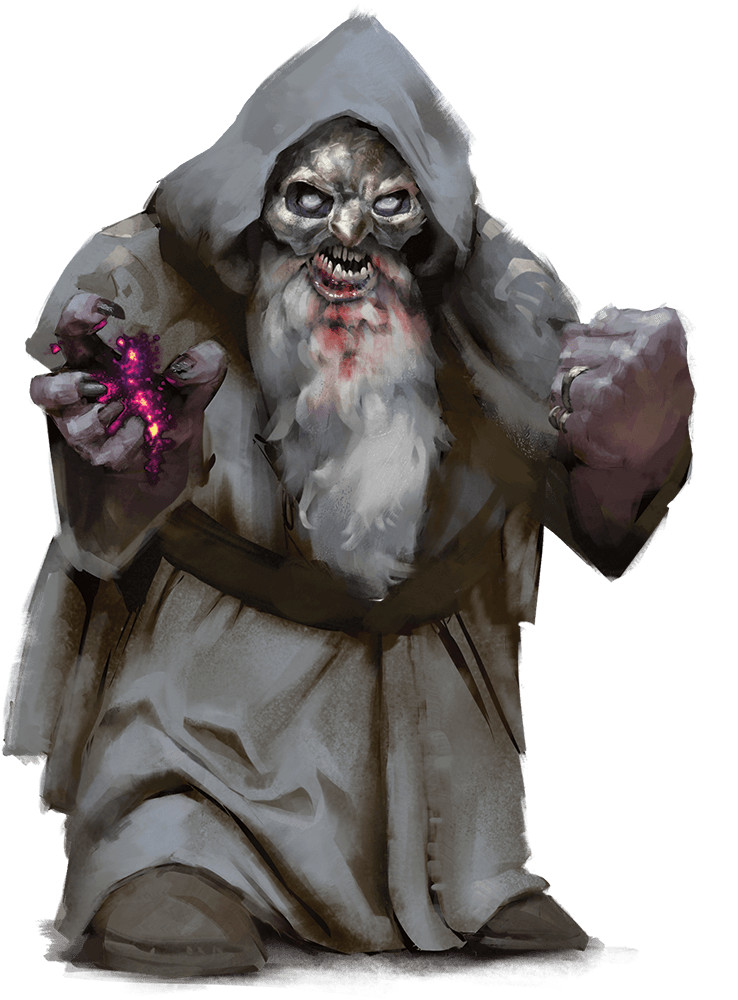
Duergar
- 5.5E/5E: Medium Humanoid; Lawful Evil; CR 12 (Despot), 2 (Hammerer), 2 (Kavalrachni), 2 (Mind Matter), 3 (Screamer), 1 (Soulblade), 2 (Stone Guard), 6 (Warlord), 2 (Xarrorn)
The
Duergar, a.k.a. those evil stone-skinned dwarf assholes, also get nine
whole new stat blocks. I never really found Duergar all that
interesting, although these random enemy variants do have a couple of
neat ones. The book does go into a fair amount of detail on Duergar culture, especially the fact that they have psionic powers that they stole from the Illithids, which makes them mechanically a lot more fun as enemies instead of just "dwarves, but they have grey skin and are assholes". I think this book details out a lot more about Duergar history and culture and make them a lot less durr-hurr-evil-dwarves. And sure, they're evil and dour and stuff, but some of the backstory given here make you almost sympathize with them. And of course, they have a lot of funky new robot-controlling psychic powers.
The Despot, for example, are cyborgs who replace parts of their body with machines that they control through innate psionic abilities. The Hammerer, meanwhile, is a digging machine that has an unruly Duergar strapped inside as punishment, using the Duergar's pain into energy that powers the mining device. The Screamer is an equivalent, where Duergars that gossip too much get their beards shaved (the horror!) and strapped into a machine that turns their agony into sonic blasts. Because the Duergar are an evil sort who like these kinds of ironic-yet-impractical punishments. Kavalrachni is a long, bizarre name, until you realize that it's a combination of 'cavalry' and 'arachni', because they're evil psychic dwarves riding giant spiders in the Underdark. Hoo yeah!
The rest aren't that interesting, although that happens when you have a bit too many enemies. Mind Masters are spies with psychic powers; Soulblades are Duergars with psionic blades; Stone Guards are stronger Duergar soldiers, Warlords are generic leaders; Xarrorns are psychic-alchemists that construct weapons. Still, I do find the sheer amount of unexpected usage of mechanical torture tools that also double as what's essentially mecha suits to be something that I didn't think I would ever associate with the Duergar! It souds like an edgy version of WoW's many weird gnome/goblin mecha suits, but it does help to give the Duergar a bit more of a memorable identity in my brain.


Ogre
Surprisingly, we got extra ogres, and it's... well, big lumbering oafs doing big lumbering oaf things. It's not particularly super-creative, but at least the visual imagery is fun. The Ogre Battering Ram... is an ogre that carries a big-ass battering ram to smash enemy fortifications. The Ogre Bolt Launcher is a crossbowman, only because this is an ogre and not a weak little human, the ogre lugs around a straight-up ballista. Ogre Chain Brutes... just has a ball-and-chain. The Ogre Howdah... er… what's a 'howdah'? Help me out, Mirriam-Webster! Howdah [noun] hau̇-də: a seat or covered pavilion on the back of an elephant or camel. Oh, okay, that's pretty cool, like those giant elephant cavalry from human history, only instead of an elephant it's an ogre, and instead of a palanquin it's a ramshackle mess of random assorted odds-and-ends. Very fun imagery! Anyway, these ogre variants aren't super creative, but boy oh boy they're fun!
The Despot, for example, are cyborgs who replace parts of their body with machines that they control through innate psionic abilities. The Hammerer, meanwhile, is a digging machine that has an unruly Duergar strapped inside as punishment, using the Duergar's pain into energy that powers the mining device. The Screamer is an equivalent, where Duergars that gossip too much get their beards shaved (the horror!) and strapped into a machine that turns their agony into sonic blasts. Because the Duergar are an evil sort who like these kinds of ironic-yet-impractical punishments. Kavalrachni is a long, bizarre name, until you realize that it's a combination of 'cavalry' and 'arachni', because they're evil psychic dwarves riding giant spiders in the Underdark. Hoo yeah!
The rest aren't that interesting, although that happens when you have a bit too many enemies. Mind Masters are spies with psychic powers; Soulblades are Duergars with psionic blades; Stone Guards are stronger Duergar soldiers, Warlords are generic leaders; Xarrorns are psychic-alchemists that construct weapons. Still, I do find the sheer amount of unexpected usage of mechanical torture tools that also double as what's essentially mecha suits to be something that I didn't think I would ever associate with the Duergar! It souds like an edgy version of WoW's many weird gnome/goblin mecha suits, but it does help to give the Duergar a bit more of a memorable identity in my brain.
Ogre
- 5.5E/5E: Large Giant; Chaotic Evil; CR 4 (Battering Ram), 2 (Bolt Launcher), 3 (Chain Brute), 2 (Howdah)
Githyanki
- 5.5E/5E: Medium Humanoid; Lawful Evil; CR 10 (Gish), 12 (Kith'rak), 14 (Supreme Commander)
Githzerai
- 5.5E/5E: Medium Humanoid; Lawful Neutral; CR 16 (Anarch), 10 (Enlightened)
And with that... we're done with Mordenkainen's Tome of Foes, the third dedicated bestiary for the 5th Edition of Dungeons and Dragons. It's going to hardly be the end of our coverage of D&D monsters, though -- 5E alone has around two dozen-odd modules and sourcebooks, and that's without taking into account crossover sourcebooks and whatnot.
The 5E stats for the creatures we cover here:
- Allip: Medium undead; neutral evil; CR 5
- Astral Dreadnought: Gargantuan monstrosity - titan; unaligned; CR 21
- Balhannoth: Large aberration; chaotic evil; CR 11
- Berbalang: Medium aberration; neutral evil; CR 2
- Boneclaw: Large undead; chaotic evil; CR 12
- Cadaver Collector: Large construct; chaotic evil; CR 14
- Choker: Small aberration; chaotic evil; CR 1
- Bronze Scout: Medium construct; unaligned; CR 1
- Iron Cobra: Medium construct; unaligned; CR 4
- Oaken Bolter: Medium construct; unaligned; CR 5
- Stone Defender: Medium construct; unaligned; CR 4
- Corpse Flower: Large plant; chaotic evil; CR 8
- Deathlock: Medium undead; neutral evil; CR 4
- Deathlock Mastermind: Medium undead; neutral evil; CR 8
- Deathlock Wight: Medium undead; neutral evil; CR 3
- Derro: Small humanoid - derro; chaotic evil; CR 1/4
- Derro Savant: Small humanoid - derro; chaotic evil; CR 3
- Eidolon: Medium undead; any alignment; CR 12
- Sacred Statue: Large construct; as the eidolon's alignment; CR ?
- Drow Arachnomancer: Medium humanoid - elf; chaotic evil; CR 13
- Drow Favored Consort: Medium humanoid - elf; neutral evil; CR 18
- Drow House Captain: Medium humanoid - elf; neutral evil; CR 9
- Drow Inquisitor: Medium humanoid - elf; neutral evil; CR 14
- Drow Matron Mother: Medium humanoid - elf; neutral evil; CR 20
- Drow Shadowblade: Medium humanoid - elf; neutral evil; CR 11
- Duergar Despot: Medium humanoid - dwarf; lawful evil; CR 12
- Duergar Hammerer: Medium construct; lawful evil; CR 2
- Duergar Kavalrachni: Medium humanoid - dwarf; lawful evil; CR 2
- Duergar Mind Master: Medium humanoid - dwarf; lawful evil; CR 2
- Duergar Screamer: Medium humanoid - dwarf; lawful evil; CR 3
- Duergar Soulblade: Medium humanoid - dwarf; lawful evil; CR 1
- Duergar Stone Guard: Medium humanoid - dwarf; lawful evil; CR 2
- Duergar Warlord: Medium humanoid - dwarf; lawful evil; CR 6
- Duergar Xarrorn: Medium humanoid - dwarf; lawful evil; CR 2
- Githyanki Gish: Medium humanoid - gith; lawful evil; CR 10
- Githyanki Kith'rak: Medium humanoid - gith; lawful evil; CR 12
- Githyanki Supreme Commander: Medium humanoid - gith; lawful evil; CR 14
- Githzerai Anarch: Medium humanoid - gith; lawful neutral; CR 16
- Githzerai Enlightened: Medium humanoid - gith; lawful neutral; CR 10
- Ogre Battering Ram: Large giant; chaotic evil; CR 4
- Ogre Bolt Launcher: Large giant; chaotic evil; CR 2
- Ogre Chain Brute: Large giant; chaotic evil; CR 3
- Ogre Howdah: Large giant; chaotic evil; CR 2
No comments:
Post a Comment